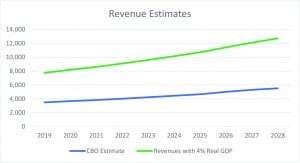“We now estimate real GDP is expanding at a 4.0 percent annual rate in Q2, up from our prior estimate of 2.75 percent and almost twice the 2.2 percent growth rate experienced in Q1.”
— JP Morgan chief U.S. economist Michael Ferol on June 14
Are real GDP growth rates of 4 percent-plus even remotely possible?
Of course they are. We experienced an extended period of real GDP growth over 4 percent annually from 1994-2000. Bill Clinton was president; Congress and the Senate were controlled by Republicans.
Before that, under President Ronald Reagan’s economic policies, we saw extended real annual economic growth rates over 4 percent from 1983-1988.
Economic booms are fueled primarily by productivity gains and pro-growth fiscal and monetary policies, not population growth as many assume. Most importantly, economic booms are fueled by abundant amounts of pure business optimism by owners and workers alike.
Business owners essentially went on strike during the Barack Obama years as they saw avalanches of federal regulation, taxes and control descend upon the American economic landscape. They reined in their hiring of new employees and capital investment for eight long years and have only recently been ignited to invest and expand by the Trump and Republican tax and economic policies.
Besides the fact that there are more job openings today in America than there are people to fill them for the first time in recent history, what else does 4 percent annual real GDP portend for our future?
For one thing, if sustainable, 4 percent annual growth for the next five years will solve our exploding budget deficit and debt dilemma. Even though our elected leaders of all parties in Washington have been reckless and irresponsible since 2001 when it comes to federal spending.


The Congressional Budget Office (CBO) publishes regular updates of economic and budget projections, most recently in April 2018 (see chart).
CBO makes pro-forma projections on a regular basis. Its predictions about what may happen is based solely on the most recent experience they can look backward at and measure.
Annual economic growth under President Obama was 1.9 percent for eight long years. Based solely on that precedent, CBO has made predictions about the next 10 years based on that same dismal rate of real growth.
Even though we now have a different president with a 180-degree different approach to business, capitalism, freedom and free enterprise.
In the attached chart, projections have been made based on 4 percent real GDP growth rates for the next 10 years, highlighted in yellow. Two percent inflation is added on for nominal GDP growth of 6 percent.
Roughly 20 percent of GDP is captured by federal income, payroll, estate and excise taxes each year, so those numbers are extrapolated from the higher GDP projections to get the new revenue numbers, also highlighted in yellow.
If, and this is a humongous “IF,” we don’t spend any more money than projected under CBO current baseline assumptions, we will balance the budget by 2024 or certainly 2025 with real economic growth rates of 4 percent of more until then (as indicated by green highlights).
Virtually all economic forecasts were wrong in 1981 when President Reagan was in office and in 1993 before the Clinton Internet boom years. No one clearly predicted real GDP growth rates exploding under each administration except the economic policy advisers in each administration who privately hoped and prayed that things would turn out better than anyone had hoped or prayed.
The absolute key factor in all of this? Congress and President Trump can not increase spending over the current baselines for the next decade. Holding overall spending to 2 percent annual growth as was done from 1994-2001 would insure fiscal sanity.
If we experience 4 percent real GDP growth for any extended period of time, that sure will be a lot of “crumbs,” as Nancy Pelosi has called it.
It will be darn near a wedding cake for every American household.



